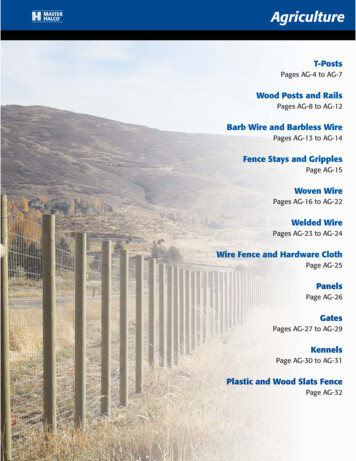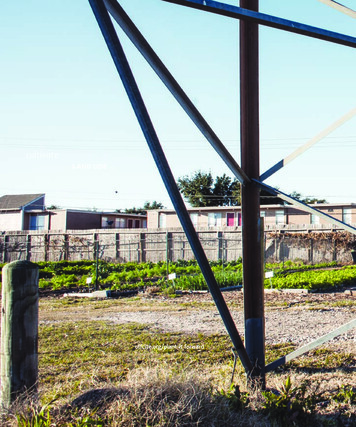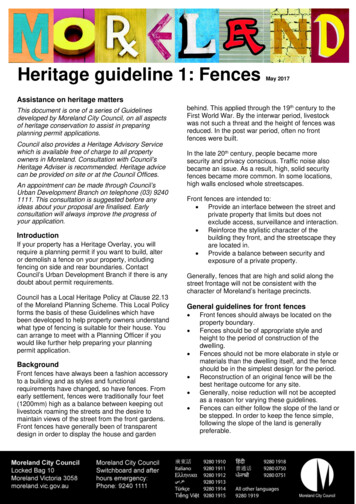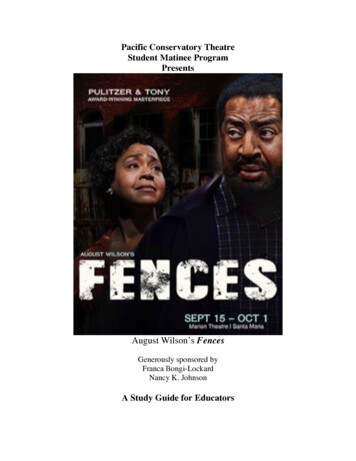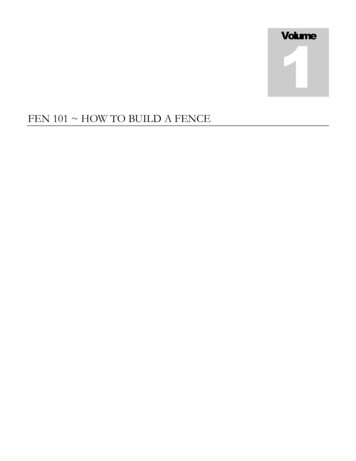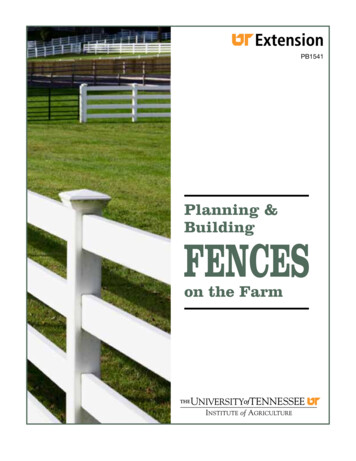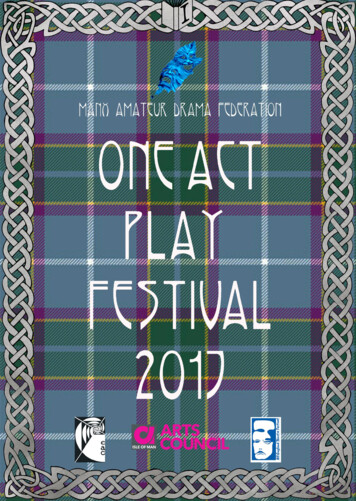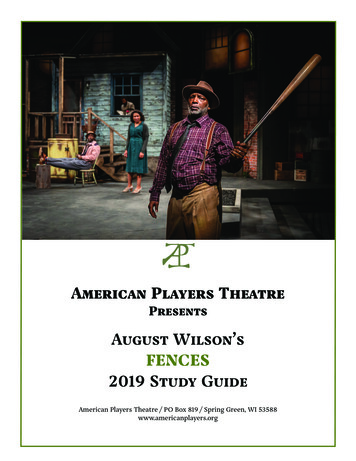
Transcription
American Players TheatrePresentsAugust Wilson’sFENCES2019 Study GuideAmerican Players Theatre / PO Box 819 / Spring Green, WI 53588www.americanplayers.org
August Wilson’s Fences2019 Study GuidePenumbra Theatre Company’s 2008 Fences Study Guide by Sarah Bellamyexcerpted with permission.APT’s Fences Production Section written by Malek Mayo.Photos by Liz Lauren. Photo of Phoebe Werner by Hannah Jo Anderson.THANKS TO THE FOLLOWING SPONSORS FORMAKING OUR PROGRAM POSSIBLEAssociated Bank * Dennis & Naomi Bahcall * Tom & Renee Boldt *Ronni Jones APT Children’s Fund at the Madison Community Foundation *Rob & Mary Gooze * IKI Manufacturing, Inc. *Kohler Foundation, Inc. * Herzfeld Foundation *THANKS ALSO TO OUR MAJOR EDUCATION SPONSORSThis project was also supported in part by a grant from the Wisconsin Arts Board with funds from the State ofWisconsin and the National Endowment for the Arts.American Players Theatre’s productions of Twelfth Night and Macbeth are part of Shakespeare in AmericanCommunities, a program of the National Endowment for the Arts in partnership with Arts Midwest.This project is supported by Dane Arts with additional funds from the Endres Mfg. Company Foundation, TheEvjue Foundation, Inc., charitable arm of The Capital Times, the W. Jerome Frautschi Foundation, and thePleasant T. Rowland Foundation.2
Special Thanks to Penumbra Theatre CompanyAccess to Penumbra's full study guide collection can be found athttps://penumbratheatre.org/study-guidesPenumbra Theatre Company occupies a very unique place within American society, and by extension ofthat, the world. Penumbra was borne out of the Black Arts Movement, a time charged by civic protest andcommunity action. An artist making art by, for and about the black community was charged with mergingaesthetic (artistic) principles with ethical (moral) ones. Subsequently, in this historical and political context, arthad an agenda to strive toward social change. African American artists were part of, and greatly influenced, thesocial currents that carried people from their homes, schools and places of worship to the streets.Bonding artistic interpretation with civic responsibility engenders an important kind of creative dissonance, aharmony of balance. It creates something neither art nor civic action could do alone. This is mission driven art,informed by a black ethos and aesthetic, which can adequately illuminate our experience. Ensemble Theatre inthat context is the creation of a community of people committed to the telling of a story that acknowledges theexperience of everyone involved. This kind of art demands that each audience member recognize his or herplace in relation to the art. When that happens, we begin to think about ourselves as interactive forces ina greater social context. Our own agency becomes clearer to us; our choices and reactions start to make sensewithin a broader, more nuanced environment. We begin to see that others have lived with similar issues, andthat their perspectives have great potential to enrich our experience and help us problem-solve. This kind of artcreates and sustains community. It encourages coalition.The function of an Education and Outreach Program inside an institution such as Penumbra Theatre Company isto use informed discussion and interdisciplinary tools to unpack the issues stimulated by the drama. Just as anactor must learn lines and blocking before interpreting a character, we offer our audiences the practical tools sothat they may respond to the art both critically and creatively. It is our job to push conversation, critical analysis,and commentary beyond emotion toward solution.We hope to create space for the themes inspired by the drama to take root and blossom. Penumbra invitesaudiences to participate in the art and social action, by using our Education and Outreach tools to locate theircontribution, their voice, within the larger human story we tell over and over again. We love. We fail. We beginanew. Over and over, told by countless tongues, embodied by some of the finest actors and carried in the heartsof some of the most committed audience members; we speak our human lessons through the prism of theAfrican American experience.3
Who’s Who in FencesTroy Maxson(David Alan Anderson)Early 50s. Legendary NegroLeague baseball player, nowworking as a garbage collector.Troy is a story-teller. He is at oncejovial and loving and brash andoverbearing. A complicated manembittered by the racism he hasexperienced throughout his life.Rose Maxson (Karen Aldridge)Mid 40s. Troy’s wife. A strong,supportive woman who is fiercelyprotective of her husband andson. A loving presence thatcounterbalances Troy’s ferocityfor life, Rose mothers almosteveryone around her. She is quietand laughs easily. A gentle spirit.Jim Bono(Bryant Louis Bentley)Early 50s. Troy’s very goodfriend. The men met while inprison and Bono, as he is known,has stayed with Troy through hislegendary days in baseball andtoday works beside him as agarbage man. Like brothers, thetwo men love each other deeply.Cory Maxson (Yao Dogbe)Late teens. Troy and Rose’s son.Cory is a natural athlete like hisfather, eager to prove his saltto the legendary Troy Maxon.He has been playing football,hoping to catch the eyes ofcollege recruiters, offering himthe educational opportunities hisilliterate father never had.Lyons Maxson (Jamal James)Mid 30s. Troy’s eldest son froma previous relationship. Lyons isa musician who cannot seem tokeep a job. He is full of laughterand uses his charming personalityto quell his father’s quick anger.A grown man, he lives with hisgirlfriend nearby.Gabriel Maxson(Gavin Lawrence)Early 40s. Troy’s brother. Afterbeing severely injured with a headtrauma in World War II, Gabriel isleft with a childlike innocence anda deep sense of concern for hisolder brother. He believes withevery fiber in his being that he isthe archangel Gabriel.Raynell Maxson (Taressa Marie Hennes, left.Phoebe Warner, right.)Nine years old. Troy’s daughter and youngestchild from an another relationship. After Alberta,the woman with whom Troy has had an affair diesin childbirth, Rose takes the baby in, and despiteher husband’s infidelity, raises her as her own.Character descriptions courtesy of Penumbra Theatre Company ‘Fences’ Study Guide, Copyright 2008.4
About the PlaySETTING (as written by the playwright)The Hill District of Pittsburgh, Pennsylvania, 1957The setting is the yard which fronts the only entrance to the Maxson household, an ancient two-story brickhouse set back off a small alley in a big-city neighborhood. The entrance to the house is gained by two or threesteps leading to a wooden porch badly in need of paint.A relatively recent addition to the house and running its full width, the porch lacks congruence. It is a sturdyporch with a flat roof One or two chairs of dubious value sit at one end where the kitchen window opens ontothe porch. An old fashioned icebox stands silent guard and opposite end.The yard is a small dirt yard, partially fenced (except during the last scene), with a wooden sawhorse, a pile oflumber, and other fence-building equipment off to the side. Opposite is a tree from which hangs a ball made ofrags. A baseball bat leans against the tree. Two oil drums serve as garbage receptacles and sit near the house atright to complete the setting.SUMMARYEvery Friday, Troy Maxson and his friend, Jim Bono celebrate the end of the work week with drinks andconversation in Troy’s back yard. The two men are garbage collectors, and Troy has asked their boss why theblack employees aren’t allowed to drive the garbage trucks, only to lift the garbage. Conversation moves to awoman Bono believes Troy was flirting with at the bar, and is concerned that Troy is cheating on his wife,Rose. Troy and Rose’s son, Cory, has been recruited by a college football team. Troy played Baseball in theNegro Leagues, but never got a chance to play in the Majors because by the time they allowed black players,Troy had aged out. Troy tells a story of his battle with death, which captivates Bono. Lyons, Troy’s son fromhis first marriage, shows up and asks Troy for money. Rose reminds Troy about the fence she’s asked him tofinish building.Cory comes home, and works on the fence, but breaks the news to Troy that he has given away his job at thelocal grocery store during the football season. Cory begs Troy to let him play because a coach from NorthCarolina is coming all the way to Pittsburgh to see him. Troy refuses and demands Cory to get his job back.In the next scene, Troy and Rose celebrate, as he’s been promoted to truck driver - the first black garbage truckdriver in the city. Bono and Troy reminisce about their fathers and their childhood experiences of leaving homein the south and moving north. Cory comes home enraged after finding out that Troy told the football coachthat Cory may not play on the team. Troy warns Cory that his outburst is “strike one,” against him.Troy has bailed his brother Gabriel out of jail. As Bono and Troy work on the fence, Bono explains to Troy andCory that Rose wants the fence because she loves her family and wants to keep them together. He thenconfronts him about cheating on Rose. Troy admits that he’s having an affair with Alberta, the woman theywere discussing in Act 1. Bono goes home to his wife. Rose enters the yard, and Troy tells her about anincident with his brother, Gabriel, that has landed him in jail. There will be a hearing to determine if Gabrielwill be forced to go back to the asylum. He then tells Rose about his affair. Rose accuses Troy of being a taker,and he grows enraged, grabbing Rose’s arm and hurting her. Cory arrives and grabs Troy from behind. Troycalls “strike two” on Cory.Six months later, Troy says he is going over to the hospital to see Alberta who went into labor early. Rose tellsTroy that Gabriel has been taken away to the asylum because Troy couldn’t read the papers and signed himaway. Alberta had a baby girl but died during childbirth. Troy challenges Death to come and get him.5
Troy brings home his baby, Raynell. Rose takes in Raynell as her own child, but refuses to be dutiful as Troy’swife, telling him, "You a womanless man."On Troy’s payday, Bono shows up unexpectedly. Things are strained between the two old friends, as theyacknowledge how each man made good on a bet they’d made that if Troy finished the fence, Bono would buyhis wife a new icebox. Bono leaves, promising emptily that the two will get together again soon.Cory arrives, and father and son begin arguing. Troy insists that Cory leave the house and provide for himself.Cory brings up Troy’s recent failings with Rose, and points out that the house and property should rightly beGabriel’s, as his government checks paid for most of the mortgage payments. Troy attacks Cory and theyfight. Troy kicks Cory out of the house for good. After Cory leaves, Troy swings the baseball bat in the air,once again taunting Death.Eight years later, Raynell plays in her newly planted garden. Troy has died from a heart attack, and Cory hasreturned home from the Marines to attend Troy’s funeral. Lyons and Bono join Rose. But at the last minute,Cory tells Rose he won’t attend. Rose tells Cory that not attending Troy’s funeral does not make Cory a man.Raynell and Cory sing one of Troy’s father’s blues songs. Gabriel turns up, released (or escaped) from thehospital. Gabe blows his trumpet but no sound comes out. He tries again but the trumpet will not play.Disappointed and hurt, Gabriel dances. He makes a cry and the Heavens open wide. He says, “That’s the waythat goes,” and the play ends.6
APT’s Production of August Wilson’s FencesBUILDING FENCESBy Malek Mayo, Assistant Director on APT’s production of Fences“I think my plays offer [them] a different way to look at black Americans. For instance, in Fences they see agarbage man, a person they don’t really look at, although they see a garbage man every day. By looking atTroy’s life, they find out that the content of this black garbage man’s life is affected by the same things—love,honor, beauty, betrayal, duty. Recognizing that these things are as much part of his life as theirs can affect howthey think about and deal with black people in their lives.”— August Wilson, excerpt from 1988 interview with journalist Bill MoyersWritten in 1985, Fences is the sixth play of August Wilson’s 10-play American Century Cycle. Wilson depictsthe lives of Black Americans with lyrical richness, theatrical compactness and emotional mass that presents thedepth of their experiences in America. He describes universal truths about the fight for dignity, love, securityand happiness in the face of overwhelming obstacles. Wilson tell his stories with a handsomeness to thelanguage that asserts that black vernacular is its own grammar.Wilson’s work was heavily influenced by the Blues. Hebelieved that Blues is a cultural expression and response tothe struggles of the Black American experience. From thetranquility of Rose’s voice to the wide range of pitches thatGabriel explores, each character in this production offers amusicality in their language. Gavin Lawrence, who playsGabriel in APT’s production, explains “August wrote from amusical place. Saying these words is like playing jazz. Thereis a theme, you improvise on the theme, and you come backto the theme.”Gabriel (Gavin Lawrence), who suffers from theBeing in an outdoor thrust theatre, there were many battleseffects of a head injury, with Rosethat we overcame such as working against the sounds of the(Karen Aldridge).woods, the wild life and the wind. Originally a poet, Wilsonis specific in all of his language, so our voice and text coachMichael Morgan worked individually with all of the actors to ensure that every word is heard and experiencedby all audience members.The Maxsons’ Hill District home is bordered with various fences that keep some out and keep some in. Somefences are constructed to trap the characters’ hopes and dreams, while others stand as guards against all thatis “the devil” to the Maxson family. Fences metaphorically barring Black athletes from professional sportsweren’t broken down until the end of Troy’s Negro Baseball League career. En route to Cory’s dream of beinga professional athlete, there stood a fence in North Carolina with “Jim Crow” painted across it. Rose built afence to protect her love for Troy for the sake of her family. Gabriel has fought off hellhounds to lead Troy pastanother fence: the one that separates this life from the next.Significance of the Hill District in FencesAugust Wilson spent the first 13 years in this neighborhood with his mother and five siblings, crammed intotwo rooms. His youth was shaped here: his mother’s guidance, family gatherings, family fights, neighborhood7
APT’s Production of August Wilson’s Fencesstories, and his yearning for knowledge and understanding of the world around him. In his early years, Wilsonwould listen to many stories of people in his neighborhood, which would eventually inspire characters in hisproductions. In Fences, the character of Troy Maxson was inspired by a Black boxing legend, Charley Burley,who lived across the street. Burley was a garbage man, a late middleweight boxer who often fought anddefeated much larger men, including the great Archie Moore, but was never granted a shot at the title. AfterWilson’s father left him when he was five, Burley became a positive male image for him. In one interview,Wilson remembered, “I wanted to grow up and dress like him. He wore those Stetson hats and things of thatsort, and I couldn’t wait until I got to be a man to be like Charley Burley.”The Hill District in 1957“ approximately 90 percent of the buildings in the area aresub-standard. and so there would be no social loss if thesewere all destroyed.” — City Councilman George E. Evans in1943Pittsburgh was in search of a place to build the Civic Arenaand chose to demolish the Lower Hill District in 1956 tocreate a building site. One-third of the neighborhood wassuddenly marked for demolition, and its residents wereevicted. Ultimately, the residents had no option other than toleave when the time came. This decision was seen attempt toget rid of any signs of black people and black culture.Stunning scenic design by Shaun Motley.Part of the beauty of this production’s set design is that it’s representative of any home in the Hill Districtduring that time. From the broken icebox to the slamming screen door, our set designer Shaun Motley wantedeverything on stage to model a typical black household in the neighborhood at that time. The Maxson yard isfilled with motifs that represent the characters of the play, particularly the ever-present baseball hanging fromthe three. The scenery shifts slightly prior to the final scene to show the passage of time. Our design team wasvery specific about what items Rose would keep in the yard after Troy’s death.Troy and RoseIn many productions of Fences, Troy is portrayed as an angry, bitter man who is tyrannical with his wife. Wedidn’t want that in this production, so were very careful to find opportunities to show Troy’s potential for love,compassion and empathy. For example, after Troy agrees to pay for half of the TV that Cory wants in Act 1,Scene 3, there’s a moment we added where Troy smiles atCory when Cory isn’t looking. We wanted the audience tosee Troy as a man who gives his sweat and blood to makesure his family has a roof over their heads, food to eat andclothes on their backs, as well as have some small things tobring them happiness.Rose (Karen Aldridge) and Troy (David AlanAnderson) in one of their more tender moments.To help understand Troy’s relationship with his family, welook at his past and upbringing. Once a great in the NegroBaseball League, Troy overcomes hardships and rises toa new form of greatness by becoming the first black trashtruck driver in the city. As a child, Troy’s father saw himas a worker instead of his son, and his mother escaped theviolent house, leaving Troy and his many siblings behind.8
APT’s Production of August Wilsons FencesWith violence and abandonment as his primary introductionto parenting, Troy breaks his back to be the best father andhusband that he can be. And because of the racism that heexperienced in his life, especially during his baseball career,he fights against Cory going to college to pursue footballin an attempt to keep Cory from trusting his future tountrustworthy white people.Providing a mirror image of Troy’s parenting style, we wereinterested in exploring the many ways that Rose is a strong,fun woman. We wanted her entrance to any scene to demandCory (Yao Dogbe) and Troy’s relationship is fraught, a specific energy and respect from the other characters. Inthough the love is clear.terms of blocking, Rose exemplifies her strength and stabilityby limiting her movement. We found her strength in thesacrifice of her life’s desires to be the best wife and mother she possibly could, offering her family the bestlove she could. Rose builds fences to keep her family united. She gives Lyons money when he comes aroundfor his weekly visits, and she backs Cory when Troy tries to dissuade him from playing football. Though Rosebends over backwards for the well being of her family, she also refuses to be anyone’s doormat. Rose has astill strength, and she won’t hesitate to set anyone straight when they get out of line. This house would not be ahome without Rose.The Context of The Negro Baseball League in FencesJosh Gibson, one of the greatest hitters of all time,was the second Negro League player inducted into theNational Baseball Hall of Fame. Troy’s character inFences, also a former Negro League player, is bitter howhe, Gibson and other Negro League stars ended up, as theplay says, “without a pot to piss in or a window to throwit out,” after the integration of Major League Baseball ledto the Negro Leagues’ shutdown.African American Hall of Famer Andrew “Rube” Fosterfounded the Negro National League in 1920. The sport’shealth seemingly stronger than ever, an estimated 3million fans watched the Negro League teams play in1942, with its World Series revived that September. Bythat point, the push to integrate major league baseballTroy’s love for baseball remains obvious, even throughhis bitterness at being overlooked due to his race.was slowly gaining steam. In 1947, the reintegrationstarted with the signing of Kansas City Monarchs’ JackieRobinson to the Brooklyn Dodgers. Robinson became thefirst 20th Century black baseball player allowed in the all-white professional league. This was soon followed bythe signing of other leading Negro League players, and the Negro Baseball Leagues quickly and quietly ended.9
Tools for TeachingReprinted with permission from Penumbra Theatre Company’s ‘Fences’ Study Guide, Copyright 2008The following are a series of questions you may use to prompt discussion, critical analysis or dialogue aboutthis play. They may be used either before or after the play, either to guide audiences toward specific issues asthey watch or, to stimulate conversation about topical issues afterward.Penumbra Theatre Company now offers Lesson Plans that use the script, the production, and the study guide toinvestigate specific themes! Developed by high school teachers and curriculum consultants Kimberly Colbertand Kaye Peters, these questions are intended to meet the state standards for High School Language Arts andLiteracy set by the Board of Education. (Grades 9 through 12). Each plan can run from approximately 15 to 45minutes for discussion. Please contact Penumbra Theatre’s Education Director for more details: sarah.bellamy@penumbratheatre.orgA Guide for Teaching August Wilson’s FencesOverviewThis guide provides a broad framework in which teachers may anchor their own classroom practice. For easyreference, lessons have been divided into five strands (mythology, literary study, themes, art and historicalcontext). Teachers may choose to follow one strand for the unit or weave together elements and/or lessons fromthe various strands. A broad essential question for the entire Fences unit is suggested, as well as more specificessential questions aligned with strands (highlighted below). The essential question provides a foundation forstudy, with guiding questions for study embedded in each lesson which will allow for a range of critical thinkingand analysis within both English/language arts and social studies content areas. Anchor, or suggested, lessonsare provided for each strand along with resource readings and classroom tools we have found effective in ourown classrooms.The suggested lessons are designed to meet high-school level Minnesota Reading and Literature and Writingstandards and Minnesota Social Studies standards for Institutions and Traditions in Society. The standards arenoted by the possible lessons in boldface type. Numbers and letters refer to the specific standard.LA - is Language Arts standards SS - is Social Studies standardsBoth the Contemporary Literary Criticism printed by Gale Group and offered as an online database and TheCambridge Companion to August Wilson, edited by Christopher Bigsby, are valuable resources on Wilson’sbody of work and are cited in the commentary and essays that follow.10
Materials:Dictionaries (at least one per group)Copies of Fences (at least one per group)Notebook paper and writing utensils for each studentPossible Lesson Outline:1. Set up expert groups. To look at first the denotative and then the connotativemeaning of these words, set up groups for a jigsaw as follows. The first "expert"groups will be a little large, but this arrangement will allow for smaller groups inthe more significant "teaching" groups. Everyone must take notes in both groups.It is critical that everyone take notes in expert groups because they will have toteach the material in the second part of the activity. Sample notes will be collectedfor teacher review and evaluation at the end of the activity. First will be the expert groups. Each of four expert groups will be responsiblefor looking up the denotative meaning of the words "home" and "fences" asfollows and brainstorming a web of literal ways in which the term is used:Group 1: Home in the common sense.Group 2: Home as it is used in baseball.Group 3: Fences in the common sense.Group 4: Fences in baseball. Students will count off by 4, random selection. These will be the expertgroups. Students should move to areas of the room designated for their group.2. Students will look up the words and create webs. Then they should look at thefollowing list of references from the play and connect these references to ideasthey already placed on the web or add to their webs.FencesHomep. 9"home runs" (Bono)p.21"Jesus be a fence" (Rose)p.34"Hell, I can hit forty-threehomeruns right now!" (Troy)p.24"put up the fence" (Bono)p.30"you supposed to be putting up thisfence" (Rose)p.31"help me with this fence" (Troy)p.40"You all line up at the door withyour hands out" (Troy)3. In expert groups, students discuss and take notes on how the meaning of these twoconcepts take on metaphorical significance in the context of the text.11
4. Set up teaching groups: In teaching groups, students will share what they learnedand discussed in their expert groups. Both groups who looked at "home" shouldpresent, followed by both "fences" groups. Students will count off by the number of students that are in the smallestgroup. If there are extras in another group, they can be distributed among thereformed "teaching" groups. Relocated to designated area of room. Studentsshould write both their teaching and expert group numbers on theirnotes.5. Group presentations.6. Group discussion. Drawing on their presentations, students will discuss and takenotes on the following questions (write on board or overhead): What does "home" mean to Troy? How does the Maxson home relate to "home" in baseball? What do you believe is the purpose of the fence Rose wants around theMaxson yard? What is the objective of a hitter in baseball when he "hits for the fences"?7. Select one person from each discussion group to tum in their notes, balancingbetween the four expert groups to get a representative sample. All students shouldkeep notes.Preparatory set (Days 3-4):Refer students to their notes from Days 1-2 and give students five minutes toreview. Follow with short discussion on what they find significant about theconcepts of "home" and "fences."Lesson Outline:1. Students should return to their teaching groups and look at the following textfrom Act II. What are the metaphorical implications raised?p. 60:Troy and Bono discuss building the fence and what material is needed.p. 61:"I don't see why Mama want a fence around the yard noways." (Cory)p. 61:"some people build fences to .keep people in." (Bono)p. 64:"I wanna see you put that fence up by-yourself." (Bono)p. 68-9:"I can step out of this house ." (Troy)p. 69:Troy's baseball analogy explaining his attraction to Alberta."safe" at home.p.70:"steal second" (Troy)p.77:"build me a fence" (Troy)p. 79:"homeless" Troy brings Raynell home and begs Rose to take her in.12
p.94:"He wasn't satisfied hitting in the seats.he want to hit it overeverything!" (Lyons speaking about Troy, his father, when he playedbaseball.)p. 95-6:Troy died swinging the bat as Rose was going into house.(Rose )2. Metaphors can reveal the complexity or duality of a concept. Consider the dualmeaning of "home" and "fences" in Fences and discuss the following questions:a. What Troy Maxon "safe at home"?b. How does the restriction implied by the fence Troy builds around theMaxon house compare to his goal as a ballplayer?c. How do these two metaphors develop your awareness of Troy Maxon' sfate as an African American man?Reflection:Students should write a short reflection, including how the metaphors helped themto understand Troy Maxon and the meaning of the play.Work Cited in Literary Study StrandKoprince, Susan. "Baseball as History and Myth in August Wilson's Fences."African American Review. Summer 2006. Bnet.,, 23 June 2008.http://finda1iicles.com/p/articles/mi m283 8.13
Themes: ResponsibilityEssential Question: What is our responsibility to ourselves vs. families and society?At the heart ofFences is a question that transcends race: "What does a man owe to hisfamily, and how much can a man, . permit himselfto ignore duty in order to pursuemore self-interested objectives?" (Blumenthal). Troy Maxon, the protagonist ofWilson'splay, through his diction, repeatedly stresses the vi1tue ofresponsibility to his sons andwife. "I done learned my mistake and learned to do what's right by it. You still trying toget something for nothing. Life don't owe you nothing. You owe it to yourself," he tellshis oldest son, Lyons, early in the play (18; 1).Yet Lyons, in his quest to be a musician, and Troy, through his philandering, show thatresponsibility is easier to talk about than uphold. In what could be the climax ofthe play,Troy squares off with his wife, Rose, after info1ming her that he has gotten anotherwoman pregnant. In explaining why he slept with Alberta, he tells Rose "I done lockedmyselfinto a pattern trying to take care ofyou all that I forgot about myself' (69; 2).As Blumenthal notes in her essay, the question ofresponsibility has more challengeswhen the individual is an African-American man in pre-Civil Rights America, but Troyand Rose's debate over responsibility at the beginning ofact 2 also has a universaldimension that begs the question of to whom and for whom we must be responsible.The following lesson is designed for the end ofthe play to help students pull togetherconcepts and themes within the play and support them with text.Fish Bowl Discussion: To Whom Are We Most Responsible?Sample Lesson: 2 daysLA Standards: I.D.1, 13, 14.SS (Peoples and Cultures) Standards:A.Identifying soc
FENCES 2019 Study Guide American Players Theatre / PO Box 819 / Spring Green, WI 53588 www.americanplayers.org. 2 August Wilson's Fences 2019 Study Guide Penumbra Theatre Company's 2008 Fences Study Guide by Sarah Bellamy excerpted with permission. APT's Fences Production Section written by Malek Mayo.
